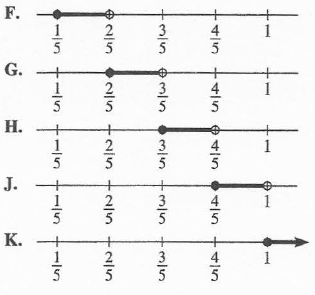(23.) ACT What is the value of the expression
$ \dfrac{|-3 - 2|^2 + (-1)^3}{16 \div 4 * 2 - 5}? \\[5ex] F.\:\: -8 \\[3ex] G.\:\: -\dfrac{2}{3} \\[5ex] H.\:\: \dfrac{2}{3} \\[5ex] J.\:\: \dfrac{26}{3} \\[5ex] K.\:\: 8 \\[3ex] $
$ \dfrac{|-3 - 2|^2 + (-1)^3}{16 \div 4 * 2 - 5} \\[5ex] \underline{Numerator} \\[3ex] |-3 - 2|^2 \\[3ex] = |-5|^2 \\[3ex] = 5^2 \\[3ex] = 25 \\[3ex] (-1)^3 \\[3ex] = (-1)(-1)(-1) \\[3ex] = -1 \\[3ex] \therefore |-3 - 2|^2 + (-1)^3 \\[3ex] = 25 + -1 \\[3ex] = 25 - 1 \\[3ex] = 24 \\[3ex] \underline{Denominator} \\[3ex] 16 \div 4 * 2 - 5 \\[3ex] = 4 * 2 - 5 \\[3ex] = 8 - 5 \\[3ex] = 3 \\[3ex] \underline{Entire\:\:Question} \\[3ex] = \dfrac{24}{3} \\[5ex] = 8 $
$ \dfrac{|-3 - 2|^2 + (-1)^3}{16 \div 4 * 2 - 5}? \\[5ex] F.\:\: -8 \\[3ex] G.\:\: -\dfrac{2}{3} \\[5ex] H.\:\: \dfrac{2}{3} \\[5ex] J.\:\: \dfrac{26}{3} \\[5ex] K.\:\: 8 \\[3ex] $
$ \dfrac{|-3 - 2|^2 + (-1)^3}{16 \div 4 * 2 - 5} \\[5ex] \underline{Numerator} \\[3ex] |-3 - 2|^2 \\[3ex] = |-5|^2 \\[3ex] = 5^2 \\[3ex] = 25 \\[3ex] (-1)^3 \\[3ex] = (-1)(-1)(-1) \\[3ex] = -1 \\[3ex] \therefore |-3 - 2|^2 + (-1)^3 \\[3ex] = 25 + -1 \\[3ex] = 25 - 1 \\[3ex] = 24 \\[3ex] \underline{Denominator} \\[3ex] 16 \div 4 * 2 - 5 \\[3ex] = 4 * 2 - 5 \\[3ex] = 8 - 5 \\[3ex] = 3 \\[3ex] \underline{Entire\:\:Question} \\[3ex] = \dfrac{24}{3} \\[5ex] = 8 $
(24.) ACT The difference $\dfrac{3}{5} - \dfrac{-1}{3}$ lies in which of the following
intervals graphed on the real number line?

$ \dfrac{3}{5} - \dfrac{-1}{3} \\[5ex] = \dfrac{3}{5} - -\dfrac{1}{3} \\[5ex] = \dfrac{3}{5} + \dfrac{1}{3} \\[5ex] LCD = 15 \\[3ex] = \dfrac{9}{15} + \dfrac{5}{15} \\[5ex] = \dfrac{9 + 5}{15} \\[5ex] = \dfrac{14}{15} \\[5ex] = 0.933333333 \\[3ex] \dfrac{4}{5} = 0.8 \\[3ex] $ Looking at the options, $\dfrac{14}{15}$ is between $\dfrac{4}{5}$ and $1$

$ \dfrac{3}{5} - \dfrac{-1}{3} \\[5ex] = \dfrac{3}{5} - -\dfrac{1}{3} \\[5ex] = \dfrac{3}{5} + \dfrac{1}{3} \\[5ex] LCD = 15 \\[3ex] = \dfrac{9}{15} + \dfrac{5}{15} \\[5ex] = \dfrac{9 + 5}{15} \\[5ex] = \dfrac{14}{15} \\[5ex] = 0.933333333 \\[3ex] \dfrac{4}{5} = 0.8 \\[3ex] $ Looking at the options, $\dfrac{14}{15}$ is between $\dfrac{4}{5}$ and $1$